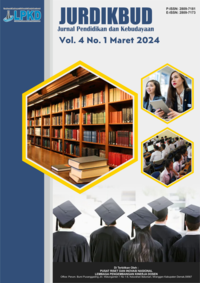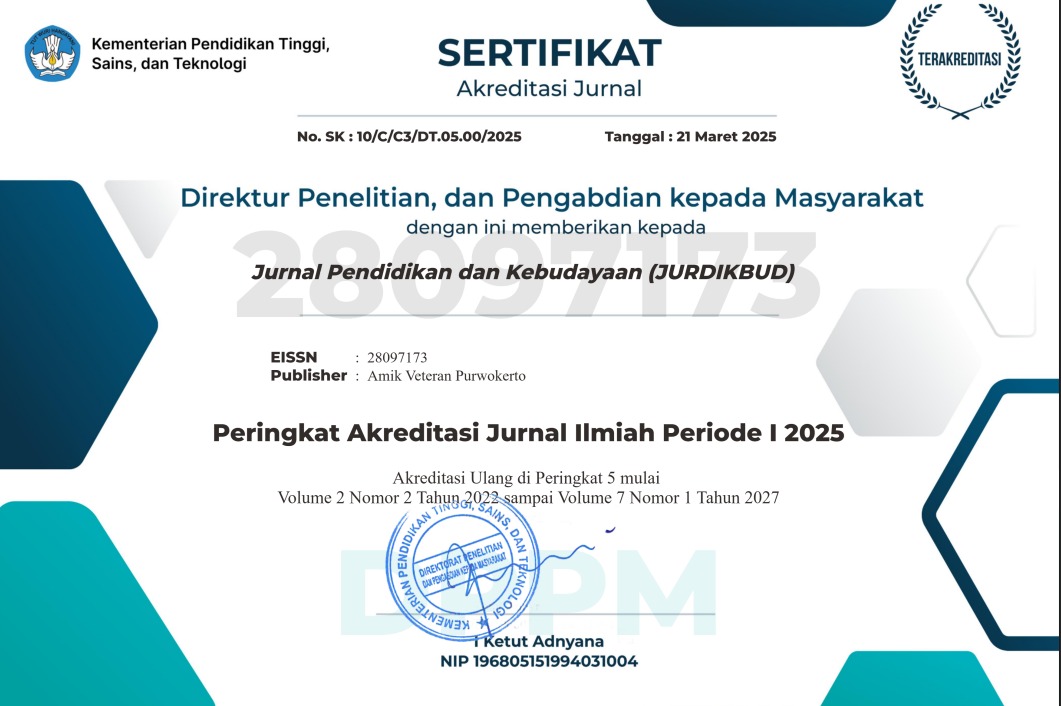Memahami Implementasi Manfaat Waktu pada Aktivitas Sehari-Hari dalam Surat Al-‘Ashr Menurut Tafsir Al-Mishbah
DOI:
https://doi.org/10.55606/jurdikbud.v5i2.7309Keywords:
Benefit, Interpretation Of Al-Mishbah, TimeAbstract
The purpose of this study is to understand the implementation of the benefits of time in daily activities in the letter al-'ashr according to the interpretation of al-mishbah. This study uses the library research method in obtaining data. The approach taken by the author is an interpretive approach and descriptive-analytical method analysis. Descriptive-analytical method analysis is an analysis that describes the thoughts of the Al-Mishbah interpretation figure, namely M. Quraish Shihab regarding understanding the implementation of the benefits of time in the letter al-'ashr which is analyzed critically, then looking for the roots of M. Quraish Shihab's thoughts. The results of this study are that Quraish Shihab's interpretation of the letter al-'ashr provides a deep understanding of the importance of time, how to use it, and how to avoid losses caused by wasting it.
References
Afifah, A. N., Nurrohim, A., Nugroho, K., & Dahliana, Y. (2025). Studi Analisis Komperatif Antara Konten Website Altafsir.com dengan Website Al-Qur’an Al-Hadi. AL-AFKAR: Journal for Islamic Studies Journal Website: Https://Al-Afkar.Com P-ISSN, 8(1), 1047–1068. https://doi.org/10.31943/afkarjournal.v8i1.2022.AL-AFKAR
Anggraini. (2020). Urgensi Waktu Dalam Surat Al-‘Aṣr Menurut Tafsir Al-Mishbah Karya Quraish Shihab. Universitas Muhammadiyah Surakarta.
Asnul. (2021). Menghitung waktu. Kementerian Keuangan Direktorat Jenderal Kekayaan Negara.
Darmawan, C. (2006). Kiat Sukses Manajemen Rasulullah: Manajemen Sumber Daya Insani Berbasis Nilai-nilai Ilahiyah. Khazanah Intelektual.
Fadilah, N., & Mahmud, H. (2024). Analisis Manajemen Waktu Dalam Qs. Al-‘Ashr: Studi Komparasi Tafsir Al-Misbah Dan Tafsir Al-Azhar. Mushaf Jurnal, 4(3), 518.
Fathonah, L. (2015). Konsep Waktu Dalam Al-Qur`An Surah Al-Ashr Ayat 1-3 Menurut M.Quraish Dalam Tafsir Al-Misbah Dan Relevansinya Dengan Pendidikan Islam. Sekolah Tinggi Agama Islam Negeri (STAIN) Ponorogo.
Fathurohman, W., & Nurrohim, A. (2024). The Development of “Ummi” Method using Hand Movements to Memorize An-Naba at RQ Muhammad Darwis Colomadu. Proceeding ISETH (International Summit on Science, Technology, and Humanity), 2128–2133. https://doi.org/10.23917/iseth.4633
Firdaus. (2022). Konsep Manajemen Waktu dalam Surat al-’Ashr (Kajian Semiotika Al-Qur’an). JIQTA: Jurnal Ilmu Al-Qur’an Dan Tafsir, 1(1), 9.
Husti, I. (2017). Studi Kritis Pemikiran Qurais Shihab Terhadap Tafsir Muhammad Husain Thabathaba’I. Al-Fikra: Jurnal Ilmiah Keislaman, 14(1), 56. https://doi.org/10.24014/af.v14i1.3902
Ismail, A., Nurrohim, A., Saib, A., & Elbanna, M. (2023). Tahsin Learning Strategy and Method To Improve the Al-Qur’an Reading Quality for the Majlis Tafsir Al-Qur’an Community in Surakarta. Profetika: Jurnal Studi Islam, 24(2), 393–420.
Jazir, & Rosyidi. (2025). Analisis Semiotika Pesan Keteladanan Dalam Film Buya Hamka. Al Yazidiy: Jurnal Sosial Humaniora Dan Pendidikan, I(1), 99–119.
Kusumaningrum, K. D. A., Azizah, A., Dahliana, Y., & Nurrohim, A. (2022). Viruses and Plague in Al-Azhar’s Tafsir: Correlation of Covid-19 Discovery with Alquran Verses. Proceedings of the International Conference on Islamic and Muhammadiyah Studies (ICIMS 2022), 676(Icims), 89–97. https://doi.org/10.2991/assehr.k.220708.012
Lestari, F., Bustanur, & Nahwiyah, S. (2024). Pengaruh Pemahaman Materi Saling Menasihati Terhadap Sikap Peduli Sosial Dalam Pembelajaran Pendidikan Agama Islam Dan Budi Pekerti Di Sekolah Menengah Atas Negeri 1 Cerenti). JOM FTK UNIKS, 4(2), 89–94.
Mubarok, A. (2017). Manajemen Waktu Dan Perencanaan Dalam Perspektif Manajemen Pendidikan Islam. Jurnal Mafhum, 2(2), 14.
Murniyetti. (2016). Waktu Dalam Perspektif Al-Qur’an. Jurnal Ulunnuha, 6, 10.
Muslim, M. N. I. (2010). Tafsir Surat Al ‘Ashr: Membebaskan Diri Dari Kerugian. Muslim.or.Id. https://muslim.or.id/2535-tafsir-surat-al-ashr-membebaskan-diri-dari-kerugian.html
Nisa, F. K., Nurrohim, A., & Apriantoro, M. S. (2024). Bibliometric Study on the Mapping of Qur’an and Health Studies Development in the Scopus Database. Proceeding ISETH (International Summit on Science, Technology, and Humanity), 2404–2416. https://doi.org/10.23917/iseth.5157
Nurrohim, A. (2019). Al-Tarjih fi Al-Tafsir: antara Makna Al-Qur’an dan Tindakan Manusia. Hermeneutik, 12(1), 93. https://doi.org/10.21043/hermeneutik.v13i2.6385
Nurrohim, A., & Nursidik, I. (2019). Hikmah dalam Al-Qur’an: Studi Tematik Terhadap Tafsir Al-Mizan. Profetika: Jurnal Studi Islam, 20(2), 181.
Romadhon, R. (2023). Makna dan Alasan Kata Al-‘Ashr Digunakan Untuk Bersumpah. Tanwir.Id.
Saepudin, D. M., Solahudin, M., & Khairani, I. F. S. R. (2007). Iman Dan Amal Saleh Dalam Alquran (Studi Kajian Semantik). Al-Bayan: Jurnal Studi Ilmu Al-Qur’an Dan Tafsir, 2(1), 10–20. https://doi.org/10.15575/al-bayan.v2i1.1805
Sari, L. I. (2024). Makna Sabar Dalam Al-Qur’an (Analisis Semiotika Charles Sandres Peirce). Al-Afkar, 7(4), 205–223. https://doi.org/10.31943/afkarjournal.v7i4.1652
Shihab, M. Q. (2002). Tafsir al-Misbah: Pesan kesan dan keserasian Al-Qur’an. Lentera Hati.
Sugiyono. (2016). Metodologi Penelitian Kuantitatif, Kualitatif, dan R&D. CV Alfabeta.
Sugiyono. (2019). Metode Penelitian Kuantitatif Kualitatif dan R&D (Sutopo, Ed.). Alfabeta.
Sundari, T. (2023). Makna dan Keutamaan Surat Al Ashr. Perpustakaan Universitas Ahamad Dahlan.
Tarmidin. (2021). Manajemen Waktu Dalam Al-Qur’an Surah Al Ashr. UIN Ar-Rainry.
Tasmaran, T. (2001). Kecerdasan Ruhaniah (p. 154). Gema Insani Press.
Terry, G. R. (1977). Principles of Management. IRWIN.
Tysara, L. (2023). Wal Ashri Artinya Demi Waktu, Simak Cara Meneladani Menurut Quraish Shihab. Liputan 6.
Yusuf Al-Qardhawi. (1995). Waktu Kekuasaan Kekayaan Sebagai Amanah Allah. Gema Insani Press.
Zebua, E. K., & Santosa, M. (2023). Pentingnya Manajemen Waktu Dalam Meningkatkan Kualitas Belajar Mahasiswa. Jurnal Pendidikan Dan Konseling, 4(2), 1349–1358.
Downloads
Published
How to Cite
Issue
Section
License
Copyright (c) 2025 Jurnal Pendidikan dan Kebudayaan (JURDIKBUD)

This work is licensed under a Creative Commons Attribution-ShareAlike 4.0 International License.








